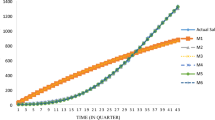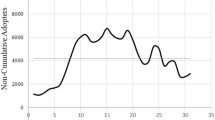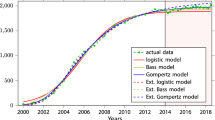Abstract
The logistic model is adopted in order to fit growth trends of innovative products for a single growth process. In the current competitive environment, we are incapable of predicting a product’s life cycle such that it can be described as a smooth S curve. Given this, we propose the use of a fuzzy piecewise regression model as a revision of the traditional logistic model. While no proper probability distribution for market share data currently exists, the proposed method is not only able to detect change-points, but can also identify predicted intervals when the growth trend of an analyzed generation is affected by other product generations. The market shares of four television technologies are used in order to demonstrate the performance of the proposed model. The results show that the proposed model outperforms the logistic model, providing both the best and worst possible market shares for the corresponding generation, and highlighting the time of impact of external influences by identifying change-points.






Similar content being viewed by others
References
Wiebe Eng: Pdf accessed (2007). Available online at http://www.productinnovators.com/greatlakes/events/documents/Wiebe
Tseng, F.M.: Quadratic interval innovation diffusion models for new product sales forecasting. J. Oper. Res. Soc. 59(8), 1120–1127 (2008)
Kang, B., Kim, H., Han, C., Yim, C.: A demand-based model for forecasting innovation diffusion. Comput. Ind. Eng. 30(3), 487–499 (1996)
Frank, L.D.: An analysis of the effect of the economic situation on modeling and forecasting the diffusion of wireless communications in Finland. Technol. Forecast. Soc. Chang. 71(4), 391–403 (2004)
Botelho, A., Pinto, L.C.: The diffusion of cellular phones in Portugal. Telecommun. Policy 28(5), 427–437 (2004)
Chu, F.L.: Using a logistic growth regression model to forecast the demand for tourism in Las Vegas. Tourism Manag. Perspect. 12, 62–67 (2014)
Meyer, P.S., Yung, J.W., Ausubel, J.H.: A primer on logistic growth and substitution: the mathematics of the Loglet Lab software. Technol. Forecast. Soc. Change 61(3), 247–271 (1999)
Kindleberger, C.P.: World Economic Primacy: 1500 to 1990. Oxford University Press, Oxford (1996)
Chen, Y.W., Carrillo, J.E.: Single firm product diffusion model for single- function and fusion products. Eur. J. Oper. Res. 214(2), 232–245 (2011)
Hao, P.Y., Chiang, J.H.: A fuzzy model of support vector regression machine. Int. J. Fuzzy Syst. 9(1), 45–50 (2007)
Tanaka, H., Uejima, S., Asai, K.: Linear regression analysis with fuzzy model. IEEE Trans. Syst. Man Cybernet. 12(6), 903–907 (1982)
Kim, K.J., Moskowitz, H., Koksalan, M.: Fuzzy versus statistical linear regression. Eur. J. Oper. Res. 92(2), 417–434 (1996)
Savic, D.A., Pedrycz, W.: Evaluation of fuzzy linear regression models. Fuzzy Sets Syst. 39(1), 51–63 (1991)
Huang, C.H.: An Effective Method for a Fuzzy multiobjective program with quasiconcave membership functions and fuzzy coefficients. Int. J. Fuzzy Syst. 16(2), 256–264 (2014)
Wang, H.F., Tsaur, R.C.: Resolution of fuzzy regression model. Eur. J. Oper. Res. 126(3), 637–650 (2000)
Redden, D.T., Woodal, W.H.: Properties of certain fuzzy linear regression methods. Fuzzy Sets Syst. 64(3), 361–375 (1994)
Yu, J.R., Tzeng, G.H., Li, H.L.: General fuzzy piecewise regression analysis with automatic change-point detection. Fuzzy Sets Syst. 119(2), 247–257 (2001)
Yu, J.R., Tzeng, G.H.: Fuzzy multiple objective programming in an interval piecewise regression model. Int. J. Uncertain. Fuzziness Knowl.-Based Syst. 17(3), 365–376 (2009)
Huang, C.Y., Tzeng, G.H.: Multiple generation product life cycle predictions using a novel two-stage fuzzy piecewise regression analysis method. Technol. Forecast. Soc. Change 75(1), 12–31 (2008)
Victor, N.M., Ausubel, J.H.: DRAMs as model organisms for the study of technological evolution. Technol. Forecast. Soc. Change 69(3), 243–262 (2002)
Merigó, J.M.: Fuzzy multi-person decision making with fuzzy probabilistic aggregation operators. Int. J. Fuzzy Syst. 13(3), 163–174 (2011)
Xu, W., Peng, X., Xiao, W.: The fuzzy jump-diffusion model to pricing european vulnerable options. Int. J. Fuzzy Syst. 15(3), 317–325 (2013)
Chang, Y.O., Ayyub, B.M.: Fuzzy regression methods—a comparative assessment. Fuzzy Sets Syst. 119(2), 187–203 (2001)
Seber, G.A.F., Wild, C.J.: Nonlinear Regression. Wiley, New York (1989)
Zimmermann, H.J.: Fuzzy programming and linear programming with several objective functions. Fuzzy Sets Syst. 1(1), 45–55 (1978)
Tseng, F.M., Lin, Y.T., Yang, S.C.: Combining conjoint analysis, scenario analysis, the Delphi method, and the innovative diffusion model to analyze the development of innovative products in Taiwan’s TV market. Technol. Forecast. Soc. Change 79(8), 1462–1473 (2012)
DisplaySearch: DisplaySearch reports Q4’07 worldwide LCD TV shipments surpass CRTs for first time; TV revenues reach a record high, up 10 % to $33B. Available online at http://www.displaysearch.com/cps/rde/xchg/SID-0A424DE8-4B97D365/displaysearch/hs.xsl/6138.asp (2008)
CENS: CPT closes CRT/CDT production lines in Mainland China. Available online at http://www.emsnow.com/newsarchives/archivedetails.cfm?ID=21702 (2008)
Lai, H.H.: The growth of Taiwan’s IT industry: holding the new chance of projector technology. TRI Industry Report 8 (In Chinese), 2004
Harris, J.: Sony to exit rear projection TV market. Available online at http://www.techwatch.co.uk/2007/12/21/sony-to-exit-rear-projection-tv-market/ (2007)
PIDA: Large-scale display industry and technology survey in 2000. 2000 Technology and Industry Competitiveness Plan, Series 00-008 (in Chinese) (2000)
Shinoda, T., Awamoto, K.: Plasma display technologies for large area screen and cost reduction. IEEE Trans. Plasma Sci. 34(2), 279–286 (2006)
Satoru, O.: DisplaySearch: why does the price of PDP TV go up? BP Corporation Report (in Chinese). Available online at http://big5.nikkeibp.co.jp/china/news/news/200709/flat200709270130.html (2007)
Chang, S.C.: The TFT-LCD industry in Taiwan: competitive advantages and future developments. Technol. Soc. 27(2), 199–215 (2005)
Tsai, B.H., Li, Y., Lee, G.H.: Forecasting global adoption of crystal display televisions with modified product diffusion model. Comput. Ind. Eng. 58(4), 553–562 (2010)
Zhang, C.H.: LCD Development Trend in 2007. Topology Research Institute, Beijing (2006). (in Chinese)
Wang, C.E.: Taiwan TFT LCD industry positioning & next challenges—expanding Taiwan’s roles in the global FPD industry. In: The DisplaySearch 2003 Taiwan FPD International Conference (2003)
Hwang, S.S.: The Trends and Market Opportunity of PDP Display Industry. Photonics Industry & Technology Development Association, Taipei (2001)
Acknowledgment
The authors gratefully acknowledge the helpful comments and suggestions of the reviewers, which have improved the quality of the paper. This research is supported by the National Science Council, Taiwan (NSC 99-2410-H-260-045 and MOST 101-2410-H-155-008-MY2).
Author information
Authors and Affiliations
Corresponding author
Rights and permissions
About this article
Cite this article
Yu, J.R., Tseng, FM. Fuzzy Piecewise Logistic Growth Model for Innovation Diffusion: A Case Study of the TV Industry. Int. J. Fuzzy Syst. 18, 511–522 (2016). https://doi.org/10.1007/s40815-015-0066-8
Received:
Accepted:
Published:
Issue Date:
DOI: https://doi.org/10.1007/s40815-015-0066-8




